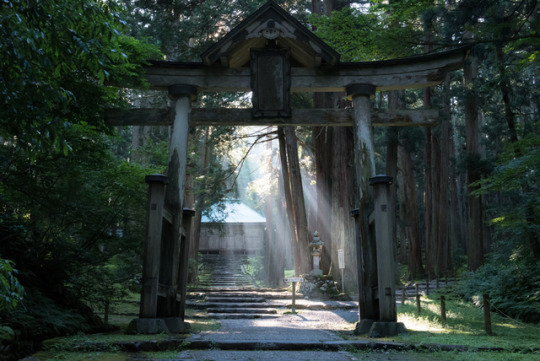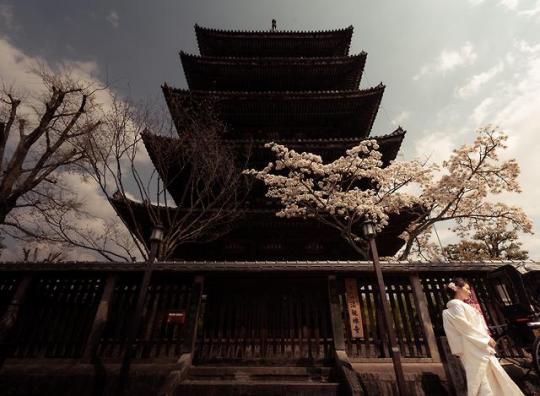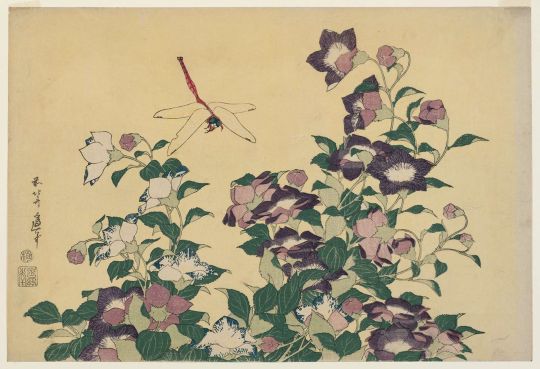Text
Japanese vocab 30~
あいじん (愛人)- lover
あやしい (怪しい)- suspicious
うで (腕)- arm
カーテン- curtain
かかる (掛かる)- to be locked
くび (首)- neck
ちょうど- just, precisely
じむしょ (事務所)- office
しゅっぱんしゃ (出版社)- publisher
そうべつかい (送別会)- farewell party
たしか (確か)- definite, certain
たったいま (たった今)- just now
てんきんする (転勤する)- to be transferred
とつぜん (突然)- sudden, suddenly
ぬる (塗る)- to paint
ひるま (昼間)- daytime,during the day
ふどうさんや (不動産屋)- estate agency
ペンキ- paint
170 notes
·
View notes
Text
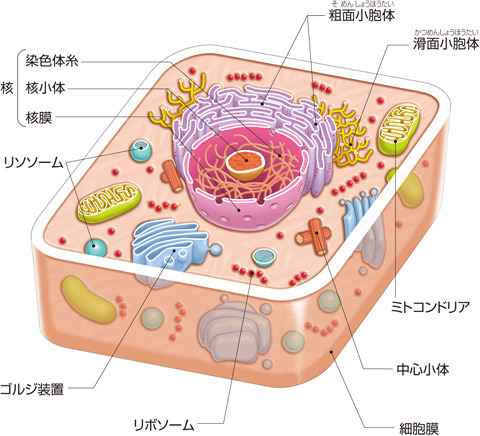
細胞のしくみ 「さいぼうのしくみ」 Structure of a cell
核 「かく」 Nucleus
染色体糸 「せんしょくたいし」 Chromosome
核小体 「かくしょうたい」 Nucleolus
核膜 「かくまく」 Nuclear membrane
粗面小胞体 「そめんしょうほうたい」 Rough endoplasmic reticulum
滑面小胞体 「かつめんしょうほうたい」 Smooth endoplasmic reticulum
ミトコンドリア Mitochondria
中心小体 「ちゅうしんしょうたい」 Centriole
細胞膜 「さいぼうまく」 Cellular membrane
リボソーム Ribosome
ゴルジ装置 「ゴルジそうち」 Golgi apparatus
リソソーム Lysosome
493 notes
·
View notes
Text
Giant Freaking Japanese Color List
This list’s intention is to give quite a few common-ish colors a home together in one post for learning purposes and spicing up one’s color vocabulary. For color names that don’t match their English equivalents, I’ve given what I feel is the most accurate translation of the name, plus the literal meaning of the Japanese name for the color. I’ve mostly excluded color names like
真っ黒(まっくろ)pure black
墨色(すみいろ)inky black (literally ink color)
濡れ羽色(ぬればいろ)jet black (literally wet wing color)
烏羽色(からすばいろ) glossy black (literally crow wing black)
鈍色(にぶいろ)dark, dull grey (literally dull color)
鉛色(なまりいろ)lead color (livid)
鼠色(ねずみいろ) darkish grey, like rat fur (literally rat color)
鋼色(はがねいろ)steel color (steel blue, blueish-gray)
桜色(さくらいろ)pale pink (literally cherry blossom color)
桃色(ももいろ)light pink (literally (Japanese) peach color)
岩礁色(がんしょういろ)coral reef color (darkish pink)
真っ赤(まっか)pure red
紅梅色(こうばいいろ)red Japanese plum color
紅色(べにいろ)crimson
鉄色(てついろ)reddish-black (literally iron color)
橙色(だいだいいろ)orange
茜色(あかねいろ)deep reddish-orange (like that of a sunset) (literally madder red)
柿色(かきいろ)reddish-brown (literally persimmon color)
朱色(しゅいろ)vermillion/ cinnabar
緋色(ひいろ)vermillion (often translated as scarlet)
鳥の子色(とりのこいろ)eggshell color (literally bird’s egg color)
玉子色(たまごいろ)light yellowish (literally egg color)
山吹色(やまぶきいろ)bright, golden yellow (literally mountain blow color (wish I knew about this one for my previous color post..))
黄土色(おうどいろ)yellow ochre
琥珀色(こはくいろ)amber color
萌黄色 (もえぎいろ) yellowish-green (literally sprouting yellow color)
柳色(やなぎいろ)pea green (literally willow green)
鶯色(うぐいいろ)similar to olive green, perhaps slightly lighter (literally Japanese nightingale green)
苔色(こけいろ)moss green
若草色(わかくさいろ)chartreuse, lime grren (literally young grass color)
翡翠色(ひすいいろ)jade green
千歳緑 (ちとせみどり)evergreen (literally 1,000 year green)
仙斎茶 or千歳茶 (せんさいちゃ)dark brownish-green (literally 1,000 year tea)
鴨���羽色(かものはいろ)teal (literally duck wing color)
青緑色 or 青緑(せいりょくしょく or あおみどり) turquoise/ aqua (literally blue-green color)
碧色(へきしょく)greenish-blue (sorta that sea water blue color)
真っ青(まっさお)pure blue
白殺しor 藍白 (しろころし or あいじろ)very light whitish blue (literally white killing or indigo white)
瓶覗色(かめのぞきいろ)lightish blue (literally water jug peek color)
水色(みずいろ)light blue (literally water color)
空色(そらいろ)sky blue
浅葱色(あさぎいろ)dark cyan (literally pale leek color.. ??)
縹色(はなだいろ)light blue
瑠璃色(るりいろ)cobalt blue
紺碧(こんぺき)azure
紺色(こんいろ)navy blue
勝つ色(かついろ)dark, blackish indigo (literally victory color)
藍色(あいいろ) indigo
藤色(ふじいろ)lavender (literally wisteria color)
ライラック lilac
菫色(すみれいろ)violet
葡萄色(えびいろ or ぶどういろ)dark purple, maroon (literally shrimp color or grape color respectively)
ベージュ色(ベージュいろ)beige
肌色(はだいろ)skin color
茶色(ちゃいろ)tawny brown, lightish brown (literally tea color)
狐色(きつねいろ)light brown, orangish-brown (literally fox color)
褐色(かっしょく)brown
鳶色(とびいろ)auburn (literally black kite color (a type of bird))
焦げ茶色(こげちゃいろ)dark brown (literally burnt tea brown)
銅色(あかがねいろ)copper
青銅色(せいどういろ)bronze (that sort of greenish rusted bronze) (literally blue copper/bronze color)
—-these last few are just color-related terms—-
蛍光(けいこう)fluorescent
透明(とうめい)clear
メタリック(metallic)
Alright, that about covers everything I wanted to put in this post. I shied away from including colors that are loanwords (like オリーブ色)because they are usually pretty self-explanatory. feel free to correct me if I made any errors, or add other colors you find important which I may have missed. If people make enough additions to add other advanced colors, I may end up making a part 2 for this post. Thanks for reading.
3K notes
·
View notes
Text
A New Era! Goodbye Heisei, hello Reiwa!
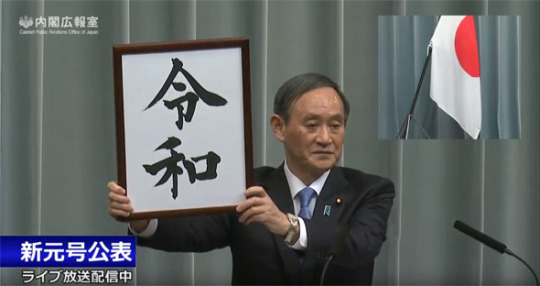
The name of the new era is officially announced! 令和 (Reiwa)
Today at about 11:30 a.m. JST the name of the next era was announced. Many Japanese people stopped what they were doing to be a part of this momentous occasion. But what does this mean? What exactly is an era? Let’s dive into it!
What is an era?
Japan has been using their own unique method of counting years based on the reign of the emperor since 645 AD, adapted from the Chinese method of dating using dynasties. This method is called 元号 (gengou). To date, there has been a total of 248 eras. An era begins when a new emperor ascends to the throne and ends with his death (or, in rarer cases, abdication). This time, the emperor is elderly, has health issues, and has asked to step down from the throne. This is the first abdication since 1817.
Currently, it is April 1st on the 31st year of the Heisei Era. That can be written like this:
平成31年4月1日 (Heisei 31nen, shigatsu tsuitachi)
“Heisei 31” can be abbreviated like this:
平31
H31
What’s more commonly used in Japan, gengou or the western system?
On official documents, it is standard to use gengou. Also, all money uses it to denote the year it was minted. However, nine out of ten Japanese people will tell you that the western system (西暦 seireki) is easier to understand. For this reason, people will often choose to use seireki when talking or in non-official paperwork. You will often commonly see both side-by-side, with one or the other in parentheses.
What are the eras up until now?
Lol I’m not gonna list all 248. Sorry. However, all Japanese people know all the eras from Meiji to present, so I’ll talk about those. The Meiji Era was kicked off by the Bakumatsu, in which the centuries-long system of an all-powerful shogun and largely ceremonial emperor was overthrown, and Japan opened itself up to trade with the rest of the world for the first time in over 200 years. The start of the Meiji Era marks the start of modern Japan, the beginning of a more traditional monarchy (according to western standards), and the adoption of Western technology, education, etc.
明治 Meiji
25 Jan 1868 – 30 Jul 1912
大正 Taisho
30 Jul 1912 – 25 Dec 1926
昭和 Showa
25 Dec 1926 - 7 Jan 1989
平成 Heisei
8 Jan 1989 – 30 Apr 2019
令和 Reiwa
1 May 2019 - ?
How are era names chosen?
This is actually really interesting. In centuries past, government officials would determine the gengou within 1-2 years of the emperor’s enthronement. The names were chosen using auspicious kanji like 明 (bright), 永 (eternity), 寿 (longevity), 和 (peace, Japan), etc. There were few rules, except that an era name could not be used more than once.
Nowadays, when these dates are used by all Japanese people on a daily basis instead of just by the select elite, several criteria have been established.
The meaning of the kanji must reflect the image of Japan and the way it wants Japan to move forward in history. (Nothing negative or unlucky)
The kanji must be easy to write and pronounce. (The 嘉 of 嘉永 [Kaei Era, 1848 - 1855] wouldn’t stand muster today because it’s ridiculous to write.)
It can only be two characters. (In the past, there were some eras with four kanji.)
The starting letter cannot be M, T, S, or H. (This is because the gengou is commonly shortened to “H31″ to mean Heisei 31, or 2019. If the next era used the same consonant, we wouldn’t know which era was being referred to.
It cannot be a word already in use. It cannot be used in a surname, company name, or place name of any kind.
A small group of select historians, literary experts, and political scientists (I think this time it was 8 or 10?) sequester themselves away for several long months while they decide the new gengou. The gengou is of the utmost secrecy up until it is announced, so they are completely cut off from the outside world. No phones, no television, no radio, no contact with family, no internet until it is announced. Why is it so secret? Because Japan likes to be spooky and mysterious, I guess. lol I’m honestly not sure, but it’s probably just because that’s how it’s always been done.
Since the emperor’s abdication is scheduled for April 30th, the new gengou was announced one month in advance, today. Because many computer programs and official government/business forms have been pre-made with “Hesei” on them (sort of like how we may sometimes make templates that have 20__ written on them), you can imagine how busy this change will make company and government employees. They will be spending this month creating new templates or getting rubber stamps with the new era on it and stamping over the obsolete Heisei. Poor guys.
So what does Reiwa mean?
Let’s take a look at each kanji.
令 rei
orders, ancient laws, command, decree
和 wa
harmony, Japanese style, peace, soften, Japan
When I first saw it, I thought it was something like “decree of peace,” which sounded very…militaristic? I mean, can you command that there be peace? Haha. But then I looked further, and it appears that this is taken from a line of poetry in the Man’yoshu, which is the oldest anthology of Japanese poetry.
Classical: 于時、初春令月、氣淑風和、梅披鏡前之粉、蘭薫珮後之香。
Modern: 時、初春の令月にして、氣淑く風和ぎ、梅は鏡前の粉を披き、蘭は珮後の香を薫す。
Summary: 人々が美しく心を寄せ合う中で文化が生まれ育つ
English Summary: Culture blooms and grows through the beautiful cooperation of the people.
Okay, so it’s not as dour as I thought it was at first haha. It’s actually pretty!
What do you think about the new name? Is it fitting? Do you have any other questions about eras?
5K notes
·
View notes
Text
Adjectives with Dupicate Kanji Followed by しい
So, this post idea basically boils down to my being interested in the adjectives that use the same kanji twice or phrase twice in a row following my discovery of 馬鹿馬鹿しい. Here are the ones I found which seemed most practical.
馴々しい (or 馴れ馴れしい, なれなれしい) overfamiliar
馬鹿馬鹿しい (ばかばかしい) ludicrous
若々しい (わかわかしい) youthful
生々しい (なまなましい) lively, green, fresh
騒々しい (そうぞうしい) noisy, boisterous
弱々しい (よわよわしい) frail, slender, feeble
図々しい (ずうずうしい) shameless
荒々しい (あらあらしい) rough, gruff
痛々しい (いたいたしい) painful (to look @, i.e.: a painful to look at injury)
初々しい (ういういしい) innocent/ artless
辿々しい (たどたどしい) faltering, tottering
疎々しい (うとうとしい) unfriendly, cold, distant
刺々しい (とげけとげしい) sharp, harsh (tone)
毳々しい (けばけばしい) gaudy, garish
艶々しい (つやつやしい) glossy
仰々しい (ぎょうぎょうしい) exaggerated
瑞々しい or 水々しい (みずみずしい) juicy
雄々しい (おおしい) manly, brave, heroic
空々しい (そらぞらしい) aloof, hypocritical
毒々しい (どくどくしい) (1) poisonous, venomous, poisonous-looking; (2) detestable, loathsome; (3) gaudy, garish, heavy
清々しい (すがすがしい) refreshing (feeling, scene, wind, air, etc.), brisk
忌々しい (いまいましい) annoying, provoking
重々しい (おもおもしい) grave, dignified, solemn
苦々しい (にがにがしい) bitter, loathsome, shameful
軽々しい (かるがるしい) indiscreet, thoughtless, careless
Thanks for reading!
1K notes
·
View notes
Photo
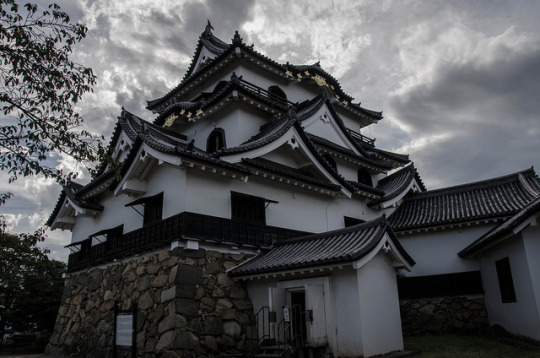
Hikone Castle, Shiga / 彦根城(滋賀) by Kaoru Honda on Flickr.
19K notes
·
View notes
Text
Kanji Spotlight #20: 欲
The kanji 欲 means “greed, craving, or desire.” This post will take a look at how it can be added to the end of words as a suffix.
知識欲 (ち・しき・よく) thirst for knowledge, formed from 知識 (knowledge, in turn made of 知 (to know) and 識 (consciousness)) and 欲 (desire)
権力欲 (けん・りょく・よく) lust for power, formed from 権力 (political power, in turn made of 権 (right (to do sth)) and 力 (strength)) and 欲 (desire)
創作欲 (そう・さく・よく) creative urge, formed from 創作 (create, in turn made of 創 (to make/ build) and 作る (to make)) and 欲 (desire)
変態性欲 (へん・たい・せい・よく) sexual perversion, formed from 変態性 (sexual perversion, in turn made of 変(to change), 態(form), and 性(gender)) and 欲 (desire)
愛欲 (あい・よく) sexual passion/ lust, formed from 愛 (love) and 欲 (desire)
征服欲 (せい・ふく・よく) lust for conquest, formed from 征服 (conquest, in turn made of 征(subjugate) and 服 (clothes)) and 欲 (desire)
庇護欲 (ひ・ご・よく) desire to protect, formed from 庇護 (protection, in turn made of 庇 (to protect someone) and 護 (safeguard, protect)) and 欲 (desire)
I apologize for the long break between posts. Thanks for reading!
133 notes
·
View notes
Text
N5 verb list
会う (あう)- to meet
開く (あく)- to become open
開ける (あける)- to open
上げる (あげる)- to give
遊ぶ (あそぶ)- to play, to make a visit
あびる - to bathe, to shower
洗う (あらう)- to wash
ある - to be, to have (inanimate)
歩く (あるく)- to walk
言う (いう)- to say
行く (いく)- to go
居る (いる)- to be, to have (animate)
要る (いる)- to need
入れる (いれる)- to put in
歌う (うたう)- to sing
生まれる (うまれる)- to be born
売る (うる)- to sell
起きる (おきる)- to get up
置く (おく)- to put
教える (おしえる)- to teach, to tell
押す (おす)- to push, to stamp
覚える (おぼえる)- to remember
泳ぐ (およぐ)- to swim
降りる (おりる)- to get off, to descend
終わる (おわる)- to finish
買う (かう)- to buy
返す (かえす)- to return something
帰る (かえる)- to return, to go back
かかる - to take time or money
書く (かく)- to write
かける - to call by phone
貸す (かす)- to lend
借りる (かりる)- to borrow
消える (きえる)- to disappear
聞く (きく)- to hear, to listen, to ask
切る (きる)- to cut
着る (きる)- to put on
曇る (くもる)- to become cloudy/dim
来る (くる)- to come
消す (けす)- to erase, to turn off
答える (こたえる)- to answer
コピーする - to copy
困る (こまる)- to be worried
咲く (さく)- to bloom
差す (さす)- to stretch out, to raise
散歩する (さんぽする)- to stroll
死ね (しね)- to die
閉まる (しまる)- to close, to be closed
閉める (しめる)- to close something
締める (しめる)- to tie
知る (しる)- to know
吸う (すう)- to smoke
住む (すむ)- to live in
する - to do
座る (すわる)- to sit
掃除する (そうじする)- to clean, to sweep
出す (だす)- to put out
立つ (たつ)- to stand
頼む (たのむ)- to ask
食べる (たべる)- to eat
違う (ちがう)- to differ
使う (つかう)- to use
疲れる (つかれる)- to get tired
着く (つく)- to arrive at
作る (つくる)-to make
つける - to turn on
勤める (つとめる)- to work for someone
出かける (でかける)- to go out
できる - to be able to
出る (でる)- to leave, to go out
取る (とる)- to take something
撮る (とる)- to take a photo or film
鳴く (なく)- to chirp, roar, croak etc
無くす (なくす)- to lose something
習う (ならう)- to learn
並ぶ (ならぶ)- to line up, to stand in line
並べる (ならべる)- to line up, to set up
なる - to become
脱ぐ (ぬぐ)- to take off clothes
寝る (ねる)- to sleep, to go to bed
登る (のぼる)- to climb
飲む (のむ)- to drink
乗る (のる)- to ride, to get on
入る (はいる)- to enter, to contain
はく - to wear, to put on trousers
始まる (はじまる)- to begin
走る (はしる)- to run
働く (はたらく)- to work
話す (はなす)- to speak
貼る (はる)- to stick
晴れる (はれる)- to be sunny
引く (ひく)- to pull
弾く (ひく)- to play an instrument
吹く (ふく)- to blow (wind)
降る (ふる)- to fall (rain, snow)
勉強する (べんきょうする)- to study
曲がる (まがる)- to turn, to bend
待つ (まつ)- to wait
磨く (みがく)- to brush teeth, to polish
見せる (みせる)- to show
見る (みる)- to see, to watch, to look
持つ (もつ)- to hold
休む (やすむ)- to rest
やる - to do
行く (ゆく)- to go
呼ぶ (よぶ)- to call out, to invite
読む (よむ)- to read
練習する (れんしゅうする)- to practice
分かる (わかる)- to be understood
忘れる (わすれる)- to forget
渡す (わたす)- to hand over
渡る (わたる)- to go across
6K notes
·
View notes
Photo
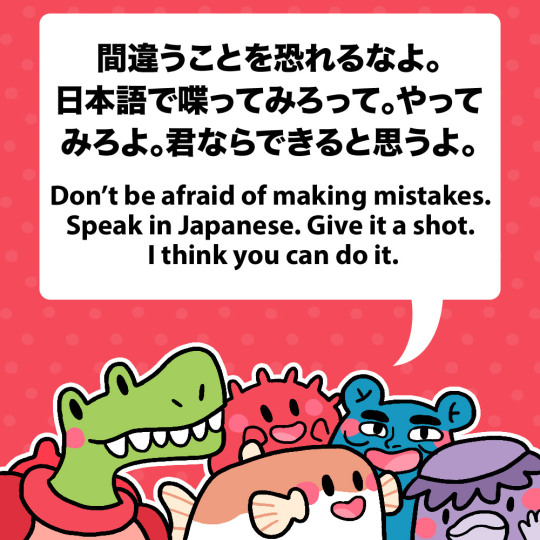
間違うことを恐れるなよ。日本語で喋ってみろって。やってみろよ。君ならできると思うよ。
まちがうことをおそれるなよ。にほんごでしゃべってみろって。やってみろよ。きみならできるとおもうよ。
Machigau koto o osoreru na yo. Nihongo de shabette mirotte. Yattemiro yo. Kimi nara dekiru to omou yo.
Don’t be afraid of making mistakes. Speak in Japanese. Give it a shot. I think you can do it.
1K notes
·
View notes
Photo

Ice Cream Village by arcreyes [-ratamahatta-] on Flickr.
974 notes
·
View notes
Text
Qualifying Nouns with Verbs and Adjectives
Types of Modifiers
In Japanese, qualifiers or modifiers of a noun always precede the modified noun. These modifiers can be:
Adjective phrases
高い本 (expensive book)
読みたい本 (the book I want to read)
Noun phrases plus の
日本語の本 (Japanese book)
Verb phrases
買う本 (the book I will buy)
買った本 (the book I bought)
Relative Clauses
Modifiers can be very long and look like sentences. For example, the entire string of words in these phrases except for the noun 本 is a modifier.
私が一番好きな本 (the book that I like the best)
父が昨日読んだ本 (the book that my father read yesterday)
父が昨日家で読んだ本 (the book that my father read at home yesterday)
This “long modifier” is also called a relative clause. It’s the part of a sentence that describes a noun. In English, the relative clause comes after the noun it describes.
For example:
The cake (that) I ate yesterday was delicious.
In English, this follows the pattern: Noun X that Y.
Noun X = a particular noun
“that Y” = a descriptor clause (i.e. a relative clause)
In Japanese, a relative clause is ordered a bit differently. It still modifies a noun, but acts like an adjective and comes directly in front of the noun it describes.
昨日食べたケーキは美味しかったです。
The cake (that) I ate yesterday was delicious.
*Note: The particle は in the above sentence is not a part of the relative clause. It is marking the relative clause as the topic of the sentence.
Rules for Writing Relative Clauses
The verb just before the noun must be in the short form, not the polite form (~ます).
When a noun-modifying clause is used in a sentence, there are always at least two predicates in the sentence.
The first predicate appears inside the relative clause. This predicate must be in the plain form.
The second predicate appears outside the relative clause (i.e. is the end of the sentence). This predicate can be either in the plain form or the polite form. (Plain forms include: た, ない, たかった, ている/でいる.)
There is no は particle inside a relative clause. The particle は is replaced by が. が is used to mark the subject because a relative clause is always a subordinate (dependent) clause.
From the earlier example:
昨日食べたケーキは美味しかったです。
First predicate = 昨日食べたケーキ (The verb 食べた is in the plain form. Verbs or adjectives in the relative clause must always be in the informal form.)
Second predicate = 美味しかったです (The conjugation of 美味しい is in the polite form. Verbs or adjectives in the second predicate can be either polite or informal.)
The particle は is outside of the relative clause (昨日たべたケーキ). It marks the relative clause as the topic of the second predicate. (i.e. What about the cake i ate yesterday? It was delicious.)
Sentence Patterns:
Color coding:
Blue = relative clause (first predicate of the sentence)
Orange = noun being described by the relative clause
Green = particles
Purple = second predicate of the sentence
Relative clause は~
Subject が verb + modified noun は predicate
Ex: 田中さんが食べている食べ物は刺身です。(The food that Tanaka-san is eating is sashimi.)
Object を verb + modified noun は predicate
Ex: あそこで写真を撮っている人はだれですか。(Who is the person taking pictures over there?)
~は Relative clause です。
Topic は object を verb + modified noun です
Ex: 昨日来た人は日本語を勉強しています。(The person who came yesterday is studying Japanese.)
Relative clause に~
Subject が verb + modified noun に predicate
Ex: 今日年末結婚した友達に手紙が来ました。(A letter came from a friend who got married last year.)
Relative clause を~
Subject が verb + modified noun を predicate
Ex: 友達は私が作ったケーキを食べました。(My friend ate the cake that I made.)
These particles determine what the relative clause is doing (its function) in the sentence:
は after the clause puts emphasis on the predicate as the topic of the sentence.
は before the clause emphasizes the clause as the topic of the sentence.
に marks the noun being modified by the relative clause as a destination.
を marks the noun being modified by the relative clause as a direct object acted on by the verb after を.
*Note: There are particles inside the relative clauses (indicated in blue). These are a part of the relative clause!
More Example Sentences
先週見た映画は面白かったです。(The movie I saw last week was interesting.)
昨日読んでいた本を図書館に返した。(I returned the book I was reading yesterday to the library.)
めがねをかけている背の高いあの人は私の先生です。(That tall person (over there) who wears/is wearing glasses is my professor.)
猫が好きな女の人は私の友達です。(That woman who likes cats is my friend.)
Different tenses can also be used:
The tense of the verb or adjective inside the relative clause (along with other time words like 明日 or 昨日) can indicate whether the rest of the sentence is talking about something in the present, past, or future.
Telling the difference between the present or future tenses in Japanese depends on the context of the sentence (e.g. time words like 明日 or 昨日).
Present tense:
彼女が今日着ているドレスはすてきです。(The dress that she is wearing today is nice.)
Future tense:
彼女が明日着るドレスはすてきです。(The dress that she will wear tomorrow is nice.)
Past tense:
彼女が昨日着ていたドレスはすてきでした。(The dress that she wore yesterday was nice.)
Learn More
# 48 Learn Japanese - How to make “Relative Clause” by Masa Sensei
@kanjikiwi‘s post about Adjectival Clauses
Relative Clause (Modifying Noun) & Word Order by Misa Sensei (Japanese Ammo with Misa)
814 notes
·
View notes
Photo

https://www.instagram.com/p/BodkMPpiqdY/?utm_source=ig_share_sheet&igshid=bpucd49yp5kk
821 notes
·
View notes
Text
japanese money & shopping
えん 円 (e•n) - the official currency of japan, the yen (¥)
おかね お金 (o•ka•ne) - money
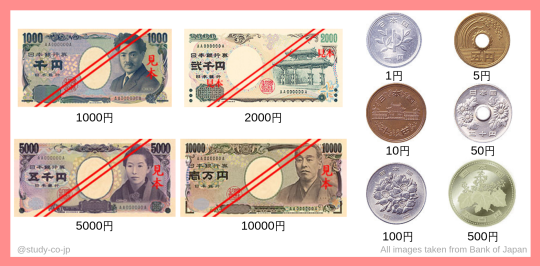
there are currently four types of bills in circulation: ¥1,000, ¥2,000 (but these are very rare), ¥5,000, and ¥10,000.
there are currently six types of coins in circulation: ¥1, ¥5, ¥10, ¥50, ¥100, and ¥500.
all the bills and coins differ in size!
although many stores in japan take credit cards, cash is the most common method of payment.
places to shop
おみせ お店 (o•mi•se) - store
デパート (de•pa•a•to) - department store
スーパー (su•u•pa•a) - supermarket
ショッピングモール (sho•ppi•n•gu•ma•a•ru) - shopping mall
ほんや 本屋 (ho•n•ya) - bookstore
buying things
かいものをする 買い物をする (ka•i•mo•no•o•su•ru) - to shop [lit. to do shopping]
いくら 幾ら (i•ku•ra) - how much
たかい 高い (ta•ka•i) - expensive
やすい 安い (ya•su•i) - cheap
some useful shopping expressions
これはいくらですか。 = How much is this?
それは...円です。 = This is … yen.
...をください。 = Please give me…
used for concrete items (i.e. when buying or ordering an item)
...をおねがいします。 = Please give me…
however, the above is used for favors and requests rather than concrete items.
1K notes
·
View notes
Photo

Komatsu Nana 小松菜奈 modelling for Kyoto Kimono Yuzen 京都きもの友禅 - Japan - December 2017
Source Twitter @kimono_yuzen
663 notes
·
View notes
